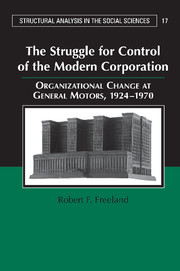 The Struggle for Control of the Modern Corporation
The Struggle for Control of the Modern Corporation Book contents
- Frontmatter
- Contents
- List of Figures and Tables
- Acknowledgments
- 1 The Modern Corporation and the Problem of Order
- 2 Creating Corporate Order: Conflicting Versions of Decentralization at GM, 1921–1933
- 3 Administrative Centralization of the M-form, 1934–1941
- 4 Participative Decentralization Redefined: Mobilizing for War Production, 1941–1945
- 5 The Split between Finance and Operations: Postwar Problems and Organization Structure, 1945–1948
- 6 Consent as an Organizational Weapon: Coalition Politics and the Destruction of Cooperation, 1948–1958
- 7 Consent Destroyed: The Decline and Fall of General Motors, 1958–1980
- 8 Conclusion
- Appendix: General Motors' Financial Performance, 1921–1987
- References
- Index
3 - Administrative Centralization of the M-form, 1934–1941
Published online by Cambridge University Press: 05 August 2011
- Frontmatter
- Contents
- List of Figures and Tables
- Acknowledgments
- 1 The Modern Corporation and the Problem of Order
- 2 Creating Corporate Order: Conflicting Versions of Decentralization at GM, 1921–1933
- 3 Administrative Centralization of the M-form, 1934–1941
- 4 Participative Decentralization Redefined: Mobilizing for War Production, 1941–1945
- 5 The Split between Finance and Operations: Postwar Problems and Organization Structure, 1945–1948
- 6 Consent as an Organizational Weapon: Coalition Politics and the Destruction of Cooperation, 1948–1958
- 7 Consent Destroyed: The Decline and Fall of General Motors, 1958–1980
- 8 Conclusion
- Appendix: General Motors' Financial Performance, 1921–1987
- References
- Index
Summary
In the aftermath of the Great Depression, General Motors and Alfred Sloan suddenly abandoned their commitment to participative decentralization. We saw in Chapter 2 that through 1933, Sloan and his top assistants fought to have divisional representatives included in long-range planning and policy creation as a means of manufacturing divisional consent. Between September 1933 and January 1934, however, Sloan and his allies changed course completely, eliminating direct divisional participation in the planning process and taking the first steps toward disbanding the interdivisional relations committees that gave the divisions less formal input into strategic planning. The new governance structure looked very much like a textbook M-form that put headquarters in command of strategic planning while leaving daily operations in the hands of the divisions. Yet it quickly led to administrative centralization in which the general office not only took charge of formulating policy but also usurped administrative decision-making concerning daily operations. This “corruption” of the M-form was quite intentional. It was carried out in the name of cost reduction, as Sloan pursued his belief that centralization created “efficiencies and economies” in operation. In this chapter, I examine the factors that led to centralization and the extent to which it was successful.
The trend toward administrative centralization unfolded in two steps. In the first, the general office took command of resources and decisions once controlled by the divisions. Between 1933 and 1937, general office staff took the place of division managers in formulating policy and began to encroach into operating decisions.
- Type
- Chapter
- Information
- The Struggle for Control of the Modern CorporationOrganizational Change at General Motors, 1924–1970, pp. 81 - 126Publisher: Cambridge University PressPrint publication year: 2000
